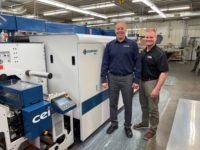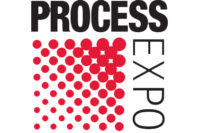When the COVID-19 pandemic hit, it created a shift in the already expanding e-commerce market. According to the United Nations Conference on Trade and Development, U.S. online retail sales grew from less than 10% in 2018 to 14% in 2020.
With the surge and demand of quick home deliveries and an ever-changing consumer environment, e-commerce is nearly impossible to ignore. It’s driving the changing production patterns of large print converters and the packaging industry as they seek efficient ways to serve their consumers.
Not only did COVID-19 accelerate the e-commerce market, but it also changed the overall consumer landscape and availability of products. We saw a shortage of aluminum cans, forcing local brewers to sell their beer exclusively in bottles. People ran to their local grocery stores to stock up on meat to freeze and shelf staples to store in pantries. Quick turns and traceability transitioned from a wish to a need to keep up with the new demand.
A flexible platform, with fast turnaround and the ability to produce high-quality graphics, was necessary to serve not only the e-commerce market but other markets, including meat packaging, health and beauty packaging, and wine and beer packaging. CPG companies that continue to seek more efficient and effective printing systems are asking the question: How do you produce smaller quantities but also leverage the equipment while moving into new markets and meeting the demand of existing markets?
The solution is hybrid printing. Memjet’s DuraLink technology, used in equipment like PCMC’s ION digital conversion system, has an aqueous pigmented ink-set offering a durable, high-speed solution for a variety of digital print needs with high-volume commercial, packaging and industrial print applications. This technology provides superior image quality for many platforms, including labels, folding cartons, flexible packaging and other specialty printing markets.
With these features, equipment like the ION offers a lower cost of entry into digital printing and a lower capital investment compared to existing presses. Hybrid systems provide print and packaging converters an advantage to expand color ranges, consolidate production, increase print lead times and meet sustainability goals.
Multiple Benefits of Hybrid Printing
Hybrid printing systems offer numerous competitive advantages. These systems open a path into new markets that may not have been previously available to customers.
With a quick changeover from long-run to short-run or variable data jobs, companies can now modify printing on the fly — something not easily done with flexo plates. Printers can switch jobs rapidly and create smaller quantity print projects relevant to a narrow market, creating short-run products that can be embellished, personalized, seasonalized and regionalized.
With a robustly designed platform, converters can expand what they want to do and incorporate the needs and additional requests from their consumers. Hybrid printing allows for nearly infinite variability, as long as the graphic fits within the color gamut that the digital platform can achieve on the substrate.
With a hybrid printing system, flexo remains the base format but the addition of digital allows easy embellishment, or the inclusion of different bar codes, new colors, wording or graphics. Digital can be used for a true short-run capacity, bypassing the setup and procurements and maintenance of print plates.
The technology isn’t new, but the popularity is starting to rise as more platforms, varieties and types of technologies are developed — all driven by an interest in application and a growing need for customization.
Safety in Variability
Interest and demand are growing for new films, labels, paperboard, pouches and bags that accept digital print because of new substrates’ ability to lock in the print. For example, one of the big interests among CPGs in the food industry is the ability to print directly on film, resulting in less contaminant migration to food surfaces through improved inks and substrates while still abiding by food contact regulations.
For verticals and their CPG companies producing food and beverages, hybrid printing offers variability in packaging; a benefit for switching from single portions to variety pack items. But perhaps even more importantly, converters now have a simple way to create multiple tracing codes, bar codes, lot numbers and small-run SKUs. The ability to easily trace a package’s journey is inherent with this technology, meaning improved safety and security.
And with the transition to a work-at-home environment during the pandemic, the planning and graphics department are far more capable of supporting this process remotely through a digital platform.
Reducing Waste in Labor and Materials
With the manufacturing industry increasingly stretched for finding trained press operators to fill vacant roles, hybrid printing systems offer relief with fewer moving parts, less hardware and less setup effort required for each job. With digitized systems, spot-checking also becomes simpler, with the advantage of easier modifications without much troubleshooting.
Hybrid printing also allows planning groups to complete quicker press setups, taking advantage of minimal effort and quick changeover in their production schedule. While pre-press setup still takes some time and configuration, in the long run it’s ultimately faster and CPGs are printing higher-quality projects.
Waste in setup, including plate tooling, plate sleeves, anilox sleeves and substrate, can also be reduced. On the maintenance side, these systems require less cleaning, storage, floor space and turnover in inventory. This means less waste, less tooling, less time setting up, less input and more output for greater quality with the fewest amount of people.
Consumer-Driven Changes Fuel Demand
Hybrid printing allows producers to offer the same durable quality print on more sustainable packaging. Digital printing, as with other forms, continues to experience demands for faster speeds, wider platforms and simple interfaces that have the capability to handle large amounts of data.
Online buying patterns and order volumes can change daily. Today’s shopper has more options and less time to shop; therefore, eye-catching graphics need to be more impactful than ever before. While poor printing was never acceptable, there’s greater market pressure for high-resolution, durable graphics on packaging that must maintain quality throughout the production and shipping processes.
Now more than ever, change is driven by the needs and preferences of the end consumer. Digital and hybrid print solutions make it even more possible for CPGs to meet these ever-changing consumer demands.




